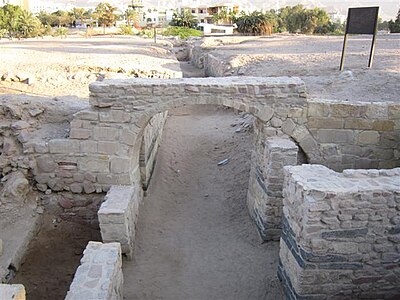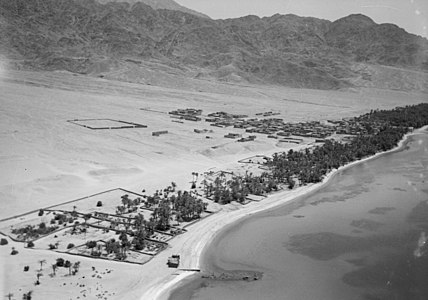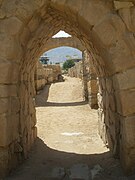Aqaba
- Afrikaans
- العربية
- Asturianu
- Azərbaycanca
- বাংলা
- Башҡортса
- Беларуская
- Български
- Català
- Čeština
- Cymraeg
- Dansk
- Deutsch
- Eesti
- Ελληνικά
- Español
- Esperanto
- Euskara
- فارسی
- Français
- Frysk
- Gaeilge
- 한국어
- Հայերեն
- Hrvatski
- Bahasa Indonesia
- Italiano
- עברית
- Jawa
- ქართული
- Қазақша
- Latviešu
- Lëtzebuergesch
- Lietuvių
- Limburgs
- Magyar
- മലയാളം
- मराठी
- مصرى
- مازِرونی
- Nederlands
- 日本語
- Norsk bokmål
- Norsk nynorsk
- Oʻzbekcha / ўзбекча
- پنجابی
- Polski
- Português
- Română
- Русский
- Scots
- Shqip
- Simple English
- Slovenčina
- Slovenščina
- کوردی
- Српски / srpski
- Srpskohrvatski / српскохрватски
- Suomi
- Svenska
- தமிழ்
- ไทย
- Türkçe
- Українська
- اردو
- ئۇيغۇرچە / Uyghurche
- Tiếng Việt
- Winaray
- 吴语
- 中文
Aqaba
الْعَقَبَة | |
|---|---|
City | |
 Clockwise from the left top: Aqaba's skyline, Aqaba Fort and Aqaba Fields, Al-Hammamat Al-Tunisyya Street in Down Town, Resort in Aqaba, Ayla old City, Aqaba Port, Aqaba Flagpole. | |
| Nickname: The Bride of the Red Sea | |
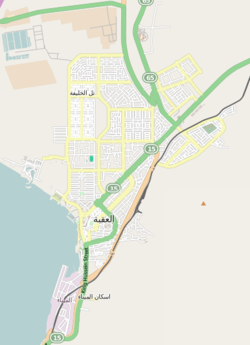 | |
| Coordinates: 29°31′55″N 35°00′20″E / 29.53194°N 35.00556°E / 29.53194; 35.00556 | |
| Country | |
| Governorate | Aqaba Governorate |
| Founded | 4000 BC |
| Authority | 2001 |
| Area | |
| • City | 375 km2 (145 sq mi) |
| Elevation | 6 m (20 ft) |
| Population (2021) | |
| • City | 95,048 [1] |
| • Density | 502/km2 (1,300/sq mi) |
| • Urban | 148,398 |
| Demonym | Aqabawi |
| Time zone | +2 Eastern European Standard Time |
| • Summer (DST) | +3 Arabia Standard Time |
| Postal code | 77110 |
| Area code | +(962)3 |
| Website | |
Aqaba (English:
Aqaba's strategic location at the northeastern tip of the
Aqaba's location next to
Name
The name of the city was anciently Elath, Ailath. The name is presumably derived from the Semitic name of a tree in the genus Pistacia.[18] Modern Eilat (established 1947), situated about 5 km north-west of Aqaba, also takes its name from the ancient settlement. In the Hellenistic period, it was renamed Berenice (in Greek Βερενίκη), but the original name survived, and under Roman rule was re-introduced in the forms Aila,[19] Aela or Haila, adopted in Byzantine Greek as Άιλα Aila and in Arabic as Ayla (آيلا).[20] The crusaders called the city Elyn.[21]
The present name al-ʿAqaba (العقبة) is a shortened from ʿaqabat Aylah (عقبة آيلة) "the mountain-pass of Ayla", first mentioned in the 12th century by Idrisi, at a time when the settlement had been mostly reduced to a military stronghold, properly referring to the pass just to the north-east of the settlement (29°33′32″N 35°05′42″E / 29.559°N 35.095°E / 29.559; 35.095, now traversed by Aqaba Highway).[22][23]
History
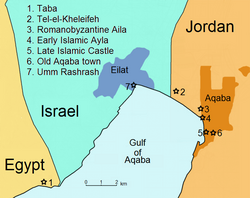
Nearby Chalcolithic sites

Excavations at two tells (archaeological mounds) Tall Hujayrat Al-Ghuzlan and Tall Al-Magass, both a few kilometres north of modern-day Aqaba city, revealed inhabited settlements from c. 4000 BC during the Chalcolithic period, with thriving copper production on a large scale.[24] This period is largely unknown due to the absence of written historical sources.[8] University of Jordan archaeologists have discovered the sites, where they found[where?] a small building whose walls were inscribed with human and animal drawings, suggesting that the building was used as a religious site. The people who inhabited the site had developed an extensive water system in irrigating their crops which were mostly made up of grapes, olives and wheat. Several different-sized clay pots were also found suggesting that copper production was a major industry in the region, the pots being used in melting the copper and reshaping it. Scientific studies performed on-site revealed that it had undergone two earthquakes, with the latter one leaving the site completely destroyed.[25]
Early history
Elath
The Edomites, who ruled over Edom just south of the Dead Sea, are believed to have built the first port in Aqaba called Elath around 1500 BC,[citation needed] turning it into a major hub for the trade of copper as the Phoenicians helped them develop their maritime economy. They profited from its strategic location at the junction of trading routes between Asia and Africa.[citation needed]
Tell el-Kheleifeh
Archaeologists have investigated an Iron Age settlement at Tell el-Kheleifeh, immediately west of Aqaba, inhabited between the 8th and 4th centuries BCE.[26]
Undefined
Around 735 BC, the city[dubious – discuss] was conquered by the Assyrian empire. Because of the wars the Assyrians were fighting in the east, their trading routes were diverted to the city and the port witnessed relative prosperity. The Babylonians conquered it in 600 BC. During this time, Elath witnessed great economic growth, which is attributed to the business background of its rulers who realized how important the city's location was. The Persian Achaemenid Empire took the city in 539 BC.[27][unreliable source?][dubious – discuss]
Classical antiquity
Hellenistic period
The
Roman period
In 64 BC, following the Roman conquest, they[who?] annexed the city and called it Aela (also Haila, Aelana, in Greek rendered Αἴλα Aila).[29][26]
Both Petra and Aela were under strong
Around AD 106 Aela was one of the main ports[clarification needed] for the Romans.[30][dubious – discuss]
Late Roman and Byzantine periods
The Aqaba Church was constructed under Roman rule between 293 and 303 and is considered to be the oldest known purpose-built Christian church in the world.[31] By the time of Eusebius, Aela became the garrison of the Legio X Fretensis, which was moved to Aela from Jerusalem.[32]

One of the oldest known texts written in the Arabic alphabet is a late 4th-century inscription found in Jabal Ram 50 kilometres (31 miles) east of Aqaba.[33]
The city became a
A citadel was also built in the area[where?][when?] that became the focal point of the Roman southern defense system.[clarification needed]
In the 6th century,
According to Ibn Ishaq, Muhammad himself reached Aila during the expedition of Tabuk of 630, and extracted tribute from the city.[37]
During the Late Byzantine or even Early Muslim period, Aila was the origin of what came to be known as the Ayla-Axum amphoras.[38]
Early Muslim period
Aila fell to the
The Early Muslim city was excavated in 1986 by a team from the University of Chicago. Artefacts are now on exhibit at Aqaba Archaeological Museum and Jordan Archaeological Museum in Amman.[citation needed] The fortified city was inscribed in a rectangle of 170 × 145 meters, with walls 2.6 meters thick and 4.5 meters high, surrounding a fortified structure, occupying an area of 35 × 55 meters.[dubious – discuss][citation needed] 24 towers defended the city. The city had four gates on all four sides, defining two main lines intersecting at the centre. The intersection of these two thoroughfares was indicated by a tetrapylon (a four-way arch), which was later transformed into a luxury residential building decorated with frescoes dated to the tenth century.[citation needed] This type of urban structure, called MSIR,[clarification needed] is typical of early Islamic fortified settlements.
-
Early Muslim Ayla
-
Early Muslim Ayla
The city prospered from 661 to 750 under the
The geographer
The city was mentioned in Medieval[when?] Arabic sources as having a mixed population of Jews and Christians. It subsequently became an important station for pilgrim caravans on the way to Mecca.[clarification needed][41]
Crusader/Ayyubid and Mamluk periods

Baldwin I of Jerusalem took over the city in 1115 without encountering much resistance. The centre of the city then moved to 500 meters along the coast to the south, and the crusader fortress of Elyn was built, which allowed the Kingdom of Jerusalem to dominate all roads between Damascus, Egypt, and Arabia, protecting the Crusader states from the east and allowing for profitable raids on trade caravans passing through the area. In order to secure this strategic position, Baldwin also built and garrisoned a fortress on Pharaoh's Island (called Île de Graye by the Franks), the modern Jazīrat Fir'aun in Egyptian territorial waters about 7 kilometres (4 miles) west of Aqaba.[21]
The garrison of Elyn (now serving primarily as a military outpost) was further strengthened in 1142 by
The old fort was rebuilt, as
Modern history
During World War I, the Ottoman forces were forced to withdraw from Aqaba in 1917 after the
-
Lawrence of Arabiaon a camel in Aqaba in 1917
-
Aqaba in 1937
-
1822 area map by Eduard Rüppell, modern borders overlaid. His "Ruines d'Elana" is the site of Tell el-Kheleifeh.
The Jordanian census of 1961 found 8,908 inhabitants in 'Aqaba.[46]
In 1965,
Geography
The city lies at Jordan's southernmost point, on the Gulf of Aqaba lying at the tip of the Red Sea. Its strategic location is shown in the fact that it is located at the crossroads of the continents of Asia and Africa, while bordering Israel, Egypt and Saudi Arabia.[49]
Climate
Aqaba has a
| Climate data for Aqaba | |||||||||||||
|---|---|---|---|---|---|---|---|---|---|---|---|---|---|
| Month | Jan | Feb | Mar | Apr | May | Jun | Jul | Aug | Sep | Oct | Nov | Dec | Year |
| Mean daily maximum °C (°F) | 20.5 (68.9) |
22.3 (72.1) |
25.9 (78.6) |
31.0 (87.8) |
35.3 (95.5) |
38.5 (101.3) |
40.0 (104.0) |
39.6 (103.3) |
36.7 (98.1) |
32.5 (90.5) |
27.0 (80.6) |
22.0 (71.6) |
30.9 (87.6) |
| Daily mean °C (°F) | 14.9 (58.8) |
16.4 (61.5) |
19.7 (67.5) |
24.3 (75.7) |
28.3 (82.9) |
31.3 (88.3) |
33.1 (91.6) |
33.0 (91.4) |
30.5 (86.9) |
26.6 (79.9) |
21.2 (70.2) |
16.4 (61.5) |
24.6 (76.3) |
| Mean daily minimum °C (°F) | 9.3 (48.7) |
10.5 (50.9) |
13.4 (56.1) |
17.6 (63.7) |
21.3 (70.3) |
24.0 (75.2) |
26.1 (79.0) |
26.3 (79.3) |
24.2 (75.6) |
20.6 (69.1) |
15.3 (59.5) |
10.8 (51.4) |
18.3 (64.9) |
| Average precipitation mm (inches) | 4.5 (0.18) |
3.7 (0.15) |
3.4 (0.13) |
1.8 (0.07) |
1.0 (0.04) |
0.0 (0.0) |
0.0 (0.0) |
0.0 (0.0) |
0.0 (0.0) |
3.0 (0.12) |
2.4 (0.09) |
4.9 (0.19) |
24.7 (0.97) |
| Average precipitation days | 2.0 | 1.4 | 1.5 | 0.8 | 0.5 | 0.0 | 0.0 | 0.0 | 0.0 | 0.6 | 0.9 | 1.9 | 9.6 |
| Source: Jordan Meteorological Department | |||||||||||||
Local government
In August 2000, the Aqaba Special Economic Zone Authority (
Administrative divisions
Jordan is divided into 12 administrative divisions, each called a
Economy




Benefiting from its location and status as Jordan's special economic zone, Aqaba's economy is based on the tourism and port industry sectors.[4][7] The economic growth in Aqaba is higher than the average economic growth in the country. Under the special economic zone status some investments and trades are exempted from taxation, as a result, new resorts, housing developments, and retail outlets are being constructed. New projects such as Tala Bay and Saraya al Aqaba are constructed aiming at providing high-end vacation and residential homes to locals and foreigners alike.
Aqaba's location next to
Over US$20 billion have been invested in Aqaba since 2001 when the Special Economic Zone was established. Along with tourism projects, Aqaba has also attracted global logistic companies such as APM Terminals and Agility to invest in logistics, which boosted the city's status as a transport and logistics hub. There are numerous hotels that reside in Aqaba but new hotels are also under construction.
Aqaba is the only seaport of Jordan so virtually all of Jordan's exports depart from here. Heavy machinery industry is also flourishing in the city with regional assembly plants being located in Aqaba such as the Land Rover Aqaba Assembly Plant. By 2008 the ASEZ had attracted $18bn in committed investments, beating its $6bn target by 2020 by a third and more in less than a decade. The goal was adjusted to bring in another $12bn by 2020, but in 2009 alone, deals worth $14bn were inked.[51] Some projects currently under construction are:
- Marsa Zayed a $10 billion is the largest mega mixed-use development project ever envisioned in both Jordan and the region. Marsa Zayed will host facilities including residential neighborhoods, commercial outlets and amenities, entertainment venues, financial and business facilities, and a number of hotels. Additionally, the property will feature marinas and a cruise ship terminal. Marsa Zayed will encompass 6.4 million square meters of built-up property.
- Saraya Aqaba, a $1.5 billion resort with a man made lagoon, luxury hotels, villas, and townhouses that will be completed by 2017.[needs update]
- Ayla Oasis, a $1.5 billion resort around a man made lagoon with hotels, villas, an 18-hole golf course designed by Greg Norman. It also has an Arabian Venice theme with apartment buildings built along canals only accessible by walkway or boat. This project will be completed by 2017.
- Tala Bay, Tala Bay was developed in a distinctive architectural style that blends Jordanian and regional architecture with total cost of US$680 million. Another distinguishing feature of this single community resort is its two-kilometer private sandy beach on the Red Sea.
- The Red Sea Astrarium (TRSA), the world's only Star Trek themed park, worth $1.5 billion would have been completed by 2014 but cancelled in 2015.
- Port relocation. Aqaba's current port will be relocated to the southernmost part of the province near the Saudi border. Its capacity will surpass that of the current port. The project costs $5 billion, and it will be completed by 2013.
- Aqaba will be connected by the national rail system which will be completed by 2013. The rail project will connect Aqaba with all Jordan's main cities and economic centers and several countries like Saudi Arabia, Iraq, and Syria.
- The Aqaba Container Terminal (ACT) handled a record 587,530 twenty-foot equivalent units (TEUs) in 2008, an increase of 41.6% on the previous year. To accommodate the rise in trade on the back of the increasing popularity of container shipping and the stabilising political situation in Iraq, the Aqaba Development Corporation (ADC) has announced plans for a new port. The port relocation 20 kilometres (12 miles) to the south will cost an estimated $600m and will improve infrastructure, while freeing up space for development in the city. Plans for upgrading the King Hussein International Airport (KHIA) and the development of a logistics centre will also help position Aqaba as a regional hub for trade and transport.[51]
Tourism

Aqaba has a number of luxury hotels, including in the Tala Bay resort 20 km further to the south, which service those who come for fun on the beaches as well as Scuba diving. Aqaba offers more than thirty primary diving locations, with the majority of them accommodating divers of all skill levels. These diving sites comprise fringing reefs that extend for over 25 kilometers, reaching all the way to the border with Saudi Arabia.
It also offers activities which take advantage of its desert location. Its many coffee shops offer

In 2006, the Tourism Division of the Aqaba Special Economic Zone Authority (
Aqaba has been chosen for the site of a new waterfront building project that would rebuild Aqaba with new man-made water structures, new high-rise residential and office buildings, and more tourist services to place Aqaba on the investment map and challenge other centers of waterfront development throughout the region.
Aqaba was chosen as the Arab Tourism City of 2011.[53][54][55][14]
During the 5-day holiday at both the end of
It is to be noted that the several development projects (i.e. Ayla, Saraya etc.) now taking place in Aqaba provide "opportunities of empowerment" for local populations that want to expand their agency within the city. According to Fulbright scholar Kimberly Cavanagh development projects will help exhibit the ways global- local partnerships and the resultant cultural exchanges, can result in mutually beneficial outcomes.[57]
Demographics
The city of Aqaba has one of the highest population growth rates in Jordan in 2011, and only 44% of the buildings in the city had been built before 1990.[58] A special census for Aqaba city was carried by the Jordanian department of statistics in 2007, the total population of Aqaba by the census of 2007 was 98,400. The 2011 population estimate is 136,200. The results of the census compared to the national level are indicated as follows:
| Demographic data of the city of Aqaba (2007) compared to Kingdom of Jordan nationwide[58] | ||||||||||
|---|---|---|---|---|---|---|---|---|---|---|
| Aqaba City (2007) | Jordan (2004 census) | |||||||||
| 1 | Total population | 98,400 | 5,350,000 | |||||||
| 2 | Growth rate | 4.3% | 2.3% | |||||||
| 3 | Male to Female ratio | 56.1 to 43.9 | 51.5 to 48.5 | |||||||
| 4 | Ratio of Jordanians to Foreign Nationals | 82.1 to 17.9 | 93 to 7 | |||||||
| 5 | Number of households | 18,425 | 946,000 | |||||||
| 6 | Persons per household | 4.9 | 5.3 | |||||||
| 7 | Percent of population below 15 years of age | 35.6% | 37.3% | |||||||
| 8 | Percent of population over 65 years of age | 1.7% | 3.2% | |||||||
Religion

ِIslam represents the majority of the population of Aqaba, but Christianity still exists today. Approximately 5,000 Christian families live in the city.[59] There are several churches in the city and multiple Christian schools including Rosary Sisters School Aqaba.[60][61]
Cityscape

Residential buildings in Aqaba are made up of 4 stories, of which are covered with sandstone or limestone. The city has no high-rises; however, Marsa Zayed project is planned to dramatically change that reality through the construction of several high-rise towers that host hotels, residential units, offices and clinics.
Culture
Museums
The largest museum in Aqaba is the Aqaba Archaeological Museum.
Lifestyle
Aqaba has recently experienced a great growth in its nightlife, especially during the dramatic increase of tourist number in the 2000s.[citation needed]
Cuisine
The fact that the city is the only coastal city in Jordan has created a distinctive cuisine relative to other Jordanian cities. Main dishes include Sayadeyah, a combination of rice, fish and spices, a dish common among Arab coastal cities. Kishnah is fish, tomatoes and onions cooked together. Bukhari is made up of rice, meat, hummus beans, ghee and spices popular with wedding ceremonies. Aqabawi desserts include Al-Hooh, which consists of layers of pastry stuffed with nuts or dates that are then fried in ghee and dipped in sugar syrup. Dates and ghee, consisting of fresh dates dipped in ghee, is a simple dessert also commonly presented to guests.[62]
Transport
Rail
The
Airports
Roads

Aqaba is connected by an 8,000 kilometres (5,000 mi) modern highway system to surrounding countries. The city is connected to the rest of Jordan by the
Port
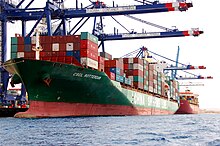
The Port of Aqaba is the only port in Jordan. Regular ferry routes to Taba are available on a daily basis and are operated by several companies such as Sindbad for Marine Transportation and Arab Bridge Maritime. The routes serve mainly the Egyptian coastal cities on the gulf like Taba and Sharm Al Sheikh.[65] In 2006, the port was ranked as being the "Best Container Terminal" in the Middle East by Lloyd's List. The port was chosen for its recent improvements and its ability to handle local traffic as well as international traffic to four neighboring countries.[70]
Wildlife
The
Divers commonly stumble upon yellow-mouthed moray eels, blue spotted stingrays, eagle rays, Napoleon wrasse, frogfish, groupers, barracuda, clownfish and many other colourful and exotic species.
The gulf of Aqaba hosts more than 390 bird species including migratory birds such as the greater flamingo, great white pelican and the pink-backed pelican.[73]
Education
The universities and institutes in Aqaba:
|
See also: List of universities in Jordan
|
Twin towns – sister cities
Aqaba is twinned with:
Gallery
-
View of Aqaba
-
The Eastern Gate of the ruins of Ayla
-
Sunset
-
View of the city
See also
- Aqaba Special Economic Zone Authority
- Disi Water Conveyance Project
- Midian
References
- ^ "The General Census – 2015" (PDF). Department of Population Statistics. Archived (PDF) from the original on 20 September 2018. Retrieved 21 January 2018.
- ISBN 3-12-539683-2
- ^ "Aqaba". The American Heritage Dictionary of the English Language (5th ed.). HarperCollins. Retrieved 27 July 2019.
- ^ a b "العقبة.. مدينة الشمس والبـــحر والسلام". Ad Dustour (in Arabic). 1 April 2016. Retrieved 22 April 2016. [permanent dead link]
- ^ "Fact Sheet". Aqaba Special Economic Zone Authority. Aqaba Special Economic Zone Authority. 2013. Archived from the original on 24 September 2017. Retrieved 27 September 2015.
- ^ a b Ghazal, Mohammad (22 January 2016). "Population stands at around 10.24 million, including 2.9 million guests". The Jordan Times. The Jordan News. Archived from the original on 8 February 2018. Retrieved 22 January 2016.
- ^ a b c "Port expansion strengthens Jordanian city of Aqaba's position as modern shipping hub". The Worldfolio. Worldfolio Ltd. 27 February 2015. Archived from the original on 27 May 2019. Retrieved 27 September 2015.
- ^ a b Florian Klimscha (2011), Long-range Contacts in the Late Chalcolithic of the Southern Levant. Excavations at Tall Hujayrat al-Ghuzlan and Tall al-Magass near Aqaba, Jordan, archived from the original on 31 August 2021, retrieved 22 April 2016
- ^ "العقبة.. ثغر الاردن الباسم". Ad-Dustor Newspaper. 21 June 2013. Archived from the original on 4 March 2016. Retrieved 27 September 2015.
- ^ a b "The Taking of Akaba – 1917 – T.E. Lawrence, Auda abu Tayi, Prince Feisal, Port of Aqaba". www.cliohistory.org. Archived from the original on 31 May 2019. Retrieved 14 October 2016.
- ^ a b "Jordan tapping popularity of UEFA Champions League to promote tourism". The Jordan Times. The Jordan News. 26 March 2015. Archived from the original on 14 April 2019. Retrieved 27 September 2015.
- ^ a b "King checks on Aqaba Mega-Projects". The Jordan Times. 7 June 2012. Archived from the original on 28 September 2015. Retrieved 27 September 2015.
- ^ a b "Aqaba has caught mega-project fever from its Gulf neighbours". Your Middle East. 29 April 2013. Archived from the original on 28 June 2016. Retrieved 27 September 2015.
- ^ ISBN 978-0-8213-5701-9. Archivedfrom the original on 16 December 2019. Retrieved 19 September 2017.
- ^ "Cross border interactions across a formerly hostile border: The case of Eilat, Israel and Aqaba, Jordan". Researchgate.net. Retrieved 5 December 2021.
- S2CID 141312410. Retrieved 5 December 2021 – via Springer Link.
- ^ "Working Paper 15 : Municipal Cooperation across Securitized Borders in the PostConflict Environment: The Gulf of Aqaba" (PDF). Euborderscapes.eu. Retrieved 5 December 2021.
- ^ Grinzweig, Michael (1993). Cohen, Meir; Schiller, Eli (eds.). "From the Items of the Name Eilat". Ariel (in Hebrew) (93–94: Eialat – Human, Sea and Desert). Ariel Publishing: 110.
- from the original on 18 May 2021. Retrieved 18 May 2021.
Aila is described as a city of Arabia
- ISBN 978-1-874044-35-2. Archivedfrom the original on 26 July 2020. Retrieved 19 September 2017.
- ^ a b Steven Runciman (1952). A History of the Crusades: The Kingdom of Jerusalem and the Frankish East 1100-1187. Vol. 2. Cambridge University Press. p. 79.
- ^ Moshe Sharon (1997). Corpus Inscriptionum Arabicarum Palaestinae. Vol. 3. p. 89.
- ^ Yoel Elitsur (2004). Ancient place names in the Holy Land. Magnes Press. p. 35.
- ISBN 978-1-884964-03-9. Archivedfrom the original on 26 July 2020. Retrieved 19 September 2017.
- ^ "اكتشافات أثرية في موقع حجيرة الغزلان بوادي اليتيم في جنوب الأردن". Alghad (in Arabic). 18 February 2008. Archived from the original on 5 March 2017. Retrieved 22 April 2016.
- ^ a b "Aqaba". ArcGIS StoryMaps. Archived from the original on 15 March 2021. Retrieved 24 November 2020.
- ^ a b "The Beach of History (3700 BC to date)". aqaba.jo. AQABA. Archived from the original on 28 September 2015. Retrieved 27 September 2015.
- ^ Mayhew 2006
- ^ In classical texts the Roman city is known as Aela, occasionally Haila or Aelana. Aela is the standard form of the name in Roman-era classical studies.
See:
Glen Warren Bowersock (1994). Roman Arabia. Harvard University Press. p. 172. ISBN 978-0-674-77756-9. Archivedfrom the original on 26 July 2020. Retrieved 20 February 2016. Neil Asher Silberman (2012). The Oxford Companion to Archaeology. Oxford University Press. p. 56.ISBN 978-0-19-973578-5. Archivedfrom the original on 26 July 2020. Retrieved 20 February 2016. Averil Cameron; Peter Garnsey, eds. (1928). The Cambridge Ancient History. Vol. 13. Cambridge University Press. p. 846.ISBN 978-0-521-30200-5. Archivedfrom the original on 26 July 2020. Retrieved 20 February 2016. [Stéphanie Benoist (editor), Rome, A City and Its Empire in Perspective (BRILL 2012ISBN 978-9-00423123-8), p. 128] Suzanne Richard, Near Eastern Archaeology: A Reader Archived 26 July 2020 at theISBN 978-1-57506083-5), p. 436
- ^ "Atlas Tours". Atlas Tours. Archived from the original on 3 November 2011. Retrieved 17 October 2011.
- ^ "First purpose-built church". Guinness World Records. Archived from the original on 17 June 2018. Retrieved 27 September 2015.
- ISBN 978-31-1022219-7), pp. 25–26 [Brian M. Fagan, Charlotte Beck (editors), The Oxford Companion to Archaeology] (Oxford University Press 1996ISBN 978-0-19507618-9), p. 617. Benjamin H. Isaac, The Near East Under Roman Rule: Selected Papers Archived 30 August 2018 at theISBN 978-9-00410736-6), p. 336
- ISBN 978-1-85284-254-3. Archivedfrom the original on 26 July 2020. Retrieved 19 September 2017.
- ^ Irfan Shahid, Byzantium and the Arabs in the Fourth Century (Dumbarton Oaks, 1984) page 345.
- ^ Siméon Vailhé, v. Aela, in Dictionnaire d'Histoire et de Géographie ecclésiastiques Archived 3 May 2015 at the Wayback Machine, vol. I, Paris 1909, coll. 647–648
- ^ Siméon Vailhé, Notes de géographie ecclésiastique Archived 6 October 2014 at the Wayback Machine, in Échos d'Orient, tome 3, nº 6 (1900), pp. 337–338
- ^ Francis E. Peters, Muhammad and the Origins of Islam, p. 241 Archived 26 July 2020 at the Wayback Machine.
- ^ M. Raith – R. Hoffbauer – H. Euler – P. Yule – K. Damgaard, The view from Ẓafār – an archaeometric study of the ʿAqaba late Roman period pottery complex and distribution in the 1st millennium CE, Zeitschrift für Orient-Archäologie 6, 2013f, 320–50
- ^ "The Oriental Institute of the University of Chicago – Aqaba Project". Aqaba project. The Oriental Institute of the University of Chicago. Archived from the original on 4 January 2014. Retrieved 7 May 2018.
- ^ "حفريات أثرية.. العقبة منطقة اقتصادية منذ 6 آلاف سنة". Al-Rai Newspaper. 10 July 2009. Archived from the original on 18 October 2015. Retrieved 28 September 2015.
- ISBN 9780521599849. Archivedfrom the original on 31 August 2021. Retrieved 17 June 2021.
- ^ Steven Runciman (1952). A History of the Crusades: The Kingdom of Jerusalem and the Frankish East 1100-1187. Vol. 2. Cambridge University Press. p. 186.
- ^ Steven Runciman (1952). A History of the Crusades: The Kingdom of Jerusalem and the Frankish East 1100-1187. Vol. 2. Cambridge University Press. p. 318.
- ^ Steven Runciman (1952). A History of the Crusades: The Kingdom of Jerusalem and the Frankish East 1100-1187. Vol. 2. Cambridge University Press. pp. 356–357.
- ^ "Jordan - History - the Making of Transjordan". Archived from the original on 21 September 2011. Retrieved 25 February 2019.
- ^ Government of Jordan, Department of Statistics, 1964, pp. 613
- ^ "Aqaba". kinghussein.gov.jo. Archived from the original on 16 November 2020. Retrieved 28 September 2015.
- ISBN 978-0-944029-18-3. Archivedfrom the original on 26 July 2020. Retrieved 19 September 2017.
- ^ "Location". aqaba.jo. Archived from the original on 29 September 2015. Retrieved 1 October 2015.
- ^ "Aseza". Aqabazone.com. Archived from the original on 5 July 2018. Retrieved 17 October 2011.
- ^ a b [1] Archived 29 August 2009 at the Wayback Machine
- ^ "Final Ann Rep Eng" (PDF). Archived (PDF) from the original on 5 March 2009. Retrieved 17 October 2011.
- ^ "King visits Aqaba Special Economic Zone Authority | ASEZA". Aqabazone.com. Archived from the original on 5 March 2016. Retrieved 17 October 2011.
- ^ Sadeh, Danny (20 June 1995). "Arkia to operate flights to Aqaba – Israel Travel, Ynetnews". Ynetnews. Ynetnews.com. Archived from the original on 1 October 2018. Retrieved 17 October 2011.
- ^ "ATO: Jordan turned Aqaba into a distinguished city". Zawya. 10 February 2010. Archived from the original on 17 June 2011. Retrieved 17 October 2011.
- ^ "Over 50,000 vacationers visited Aqaba during Eid Al Adha". jordantimes.com. 29 September 2015. Archived from the original on 1 October 2015. Retrieved 29 September 2015.
- ^ Cavanagh, Kimberly (15 May 2020). "Exploring the tourism development landscape in Aqaba". ACOR Jordan. Archived from the original on 22 November 2020. Retrieved 29 June 2020.
- ^ a b "DoS Jordan Aqaba Census" (PDF). Archived from the original (PDF) on 29 September 2011. Retrieved 17 October 2011.
- ^ "أبناء الطائفة المسيحية في العقبة يطالبون بمقعد نيابي". Al-Ghad Newspaper (in Arabic). 19 April 2012. Archived from the original on 4 June 2019. Retrieved 28 September 2015.
- ^ "Construction of a Church and Multi-Purpose Hall in Aqaba". lpj.org. 20 August 2010. Archived from the original on 18 October 2015. Retrieved 1 October 2015.
- ^ "Raising awareness on solar energy among school students in El Aqaba governorate". NATIONAL ENERGY RESEARCH CENTER. Archived from the original on 2 October 2015. Retrieved 1 October 2015.
- ^ "Culture and Traditions". aqaba.jo. Archived from the original on 29 September 2015. Retrieved 28 September 2015.
- ^ "The Red-Med Railway: New Opportunities for China, Israel, and the Middle East". Besacenter.org. 11 December 2016. Retrieved 5 December 2021.
- ^ Medzini, Ronen (27 July 2010). "Netanyahu, Abdullah discuss rail cooperation". Ynetnews. Retrieved 5 December 2021.
- ^ a b c "Getting to Aqaba". aqaba.jo. Archived from the original on 29 September 2015. Retrieved 1 October 2015.
- ^ "Israel, Jordan plan joint Aqaba airport". The Jerusalem Post. Retrieved 5 December 2021.
- ^ "Israel's New Airport Is Angering Jordan, a Rare Friend in the Region". Haaretz. Retrieved 5 December 2021.
- ^ "Airport planned for Israel-Jordan border clouds neighborly ties". Reuters.com. 22 June 2016. Retrieved 5 December 2021.
- ^ Mayhew 2006, p. 226
- ^ "Top 10 Middle East Ports". ArabianSupplyChain.com. 31 October 2006. Archived from the original on 17 March 2013. Retrieved 31 December 2012.
- ^ "Archived copy" (PDF). Archived (PDF) from the original on 28 November 2020. Retrieved 20 November 2020.
{{cite web}}: CS1 maint: archived copy as title (link) - ^ "Marine Life | Aqaba". Archived from the original on 31 October 2020. Retrieved 20 November 2020.
- ^ "Aqaba Bird Observatory - Aqaba". Archived from the original on 24 November 2020. Retrieved 20 November 2020.
- ^ "Siglato gemellaggio tra Alcamo e il Governatore di Aqaba nel Regno della Giordania". alqamah.it (in Italian). Alqama H. 26 November 2013. Archived from the original on 7 November 2020. Retrieved 2 November 2020.
- ^ "Coopération Internationale". nabeul.gov.tn (in French). Gouvernorat de Nabeul. Archived from the original on 27 September 2020. Retrieved 2 November 2020.
- ^ "Международные и межрегиональные связи". gov.spb.ru (in Russian). Federal city of Saint Petersburg. Archived from the original on 5 January 2018. Retrieved 30 June 2020.
- ^ "اتفاقية توأمة بين شرم الشيخ والعقبة". alghad.tv (in Arabic). Al Ghad. 16 December 2015. Archived from the original on 30 October 2020. Retrieved 21 October 2020.
- ^ "Aqaba's twin city Urumchi donates medical equipment for COVID-19 response". adc.jo. Aqaba Development Corporation. 15 April 2020. Archived from the original on 31 August 2021. Retrieved 30 June 2020.
Bibliography
- Mayhew, Bradley (April 2006) [1987]. Jordan (6th ed.). Footscray: ISBN 1-74059-789-3.
- Government of Jordan, Department of Statistics (1964). First Census of Population and Housing. Volume I: Final Tables; General Characteristics of the Population (PDF).
External links
- Aqaba Marketing and Tourism Directorate
- Photos of Aqaba at the American Center of Research
- Photos of Aqaba / Ayla at the American Center of Research
- Aqaba - the Jewel of the Red Sea
| International | |
|---|---|
| National | |
| Other | |



